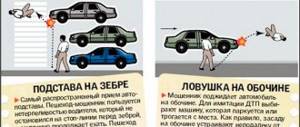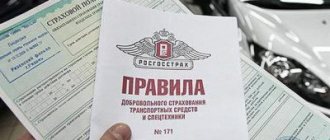Difference from similar articles
When deciding on a punishment, the article under which the actions of the guilty person are qualified is taken into account, therefore it is necessary to understand the types of crimes that are similar to theft, but provide for a different punishment and fix responsibility under another article of the Criminal Code of Russia. In particular, the actions of a guilty person are recognized as car theft only after confirmation of the motive. A similar criminal offense is theft of a vehicle.
| The difference between theft and theft | |
| Hijacking | Theft |
| The motive can be selfish (the goal is to use someone else’s vehicle for free, to ride for free) or other (the goal is revenge, envy, to scare). | The motive is exclusively selfish, the goal is to seize a stolen vehicle and turn it into one’s own favor in any form - disassembly and sale in parts, resale, personal use. |
| The commission may be associated with an attack on the owner, that is, it may be open. | Only secret seizure, when the owner of the car has no idea that a crime has been committed. |
| The punishment is imposed under Article 166 of the Criminal Code. | Prosecution occurs under Article 158 of the Criminal Code of Russia. |
Details: Punishment for theft under Article 158 of the Criminal Code of the Russian Federation
The following types of taking will not be recognized as theft:
- use of a car by a close relative, acquaintance, former spouse who previously received (or had reason to believe that he had the right to) a permit to drive a vehicle;
- operation of a company car by a company employee.
Attention! If, along with the theft of a car, a person stole property that was in the car (for example, a radio was stolen and sold, then additionally the actions are qualified under Article 158 - theft).
Additionally, it is necessary to distinguish theft (provided for in Article 166 of the Criminal Code of Russia) from the following types of violations:
- Fraud, that is, obtaining property rights to transport by deception or abuse of trust of the injured party. Punishment is applied on the basis of Article 159 of the Criminal Code of the Russian Federation, depending on the value of the stolen property and other conditions. For example, the most severe punishment for theft of vehicles worth over a million rubles is up to 10 years in prison.
- Robbery is the open taking of a car without the use of weapons or brute force (threat of physical violence). This means that the offender was aware that his criminal actions were obvious to the owner or other people around him. Liability is established under Article 161 of the Criminal Code. The maximum penalty is up to 12 years in prison.
- Robbery, that is, open seizure of a car using weapons or physical force (the threat of using it). The punishment will be imposed under Article 162 of the Criminal Code of the Russian Federation, with a maximum of up to 15 years in prison.
What and how much do they give for theft in practice?
In real practice, the punishment for car theft may depend on many factors.
First of all, this is the qualification of the crime, that is, the specific part of Article 166 of the Criminal Code of the Russian Federation under which the charge was brought. For example, part 1 of Art. 166 is a crime of moderate gravity and the chances of receiving a suspended sentence, or even ending the case with reconciliation of the parties, are very high here.
The final punishment will also depend on the identity of the hijacker. If this is a previously unconvicted idiot who took a neighbor’s “penny” for a ride in a drunken shop without asking, then everything can get by with minimal punishment or reconciliation of the parties.
In practice, under Part 1 of Article 166 of the Criminal Code of the Russian Federation, courts most often impose punishment not related to imprisonment
The maximum possible sentence for car theft in Russia is 12 years in prison (Part 4 of Article 166 of the Criminal Code of the Russian Federation).
A fine for theft can be obtained if charges are brought under parts 1 and 2 of Article 166 of the Criminal Code. Its amount is set at the discretion of the judge and can reach up to 200,000 rubles. However, in practice, its size is much smaller.
For minors who steal a car, liability begins at the age of 14. Children under this age cannot be prosecuted under Article 166 of the Criminal Code of the Russian Federation. Those same teenagers who are 16 years old will have to answer for car theft to the fullest extent of the Criminal Code of the Russian Federation, while in practice minors can be given a real sentence, although this does not happen often.
If you have a question for a lawyer about a specific situation or problem, contact an online consultant - it’s free! Questions are accepted 24 hours a day
Source
Corpus delicti
A suspect can only be brought to justice if his actions contain all the signs of a crime committed - theft, which are discussed below.
Guilty person - subject
A person who meets the following criteria can be held accountable:
- Individual (criminal punishment of organizations is impossible).
- Sanity (the absence of a stable or temporary mental disorder that interferes with awareness of one’s actions).
- Reaching the age of criminal responsibility is 14 years.
Attention! If during pre-trial proceedings it is established that the offense was committed by a minor citizen (that is, under 14 years of age), then other measures will be applied to him. Registration with the police is mandatory.
Attitude towards an unlawful act - the subjective side
Punishment for car theft is imposed only if the person committed the actions intentionally, that is, he understood that he was violating the law and the rights of others, but deliberately wanted unlawful consequences to occur.
Committing actions aimed at unlawfully taking possession of a car - the objective side
All actions aimed at taking possession of a car or other type of transport entail liability for theft. According to the Supreme Court Resolution No. 25, activation of the engine is optional, that is, punishment will be applied for the following types of actions:
- rollback;
- transportation by other transport;
- towing;
- hacking the system and leaving.
In addition, it is necessary to confirm the presence of the following mandatory characteristics:
- Illegality , that is, the person at fault did not obtain permission to use the transport and had no reason to believe that such permission had been granted.
- Confirmation of a motive that is not related to theft.
Important! The crime is considered completed from the moment the location of the vehicle changes. Even moving a few meters by any of these methods will be regarded as theft, which entails liability under Article 166 of the Criminal Code.
Object and types of transport, the possession of which entails punishment
Object – the ownership right of the owner of the vehicle. The subject of the crime may be a car or other vehicle. The category of other transport includes all mechanical modes of transport, namely:
- urban transport (trams, buses, trolleybuses);
- two-wheeled transport (mopeds, motorcycles);
- ATVs;
- agricultural machinery;
- construction self-propelled machines.
The full list and requirements for transport are indicated in the contents of the Resolution of the Supreme Court of Russia No. 25 of 2008 (hereinafter, Plenum of the Supreme Court No. 25).
The difference between car theft and theft
If the theft was committed by an organized group, or the criminal actions caused particularly large damage, the attackers can be imprisoned for up to ten years. If offenders have used or made threats of violence dangerous to life or health, they may be imprisoned for up to twelve years.
The main difference between the theft of a car and its theft is the presence or absence of selfish intent on the part of the criminal. When stealing, he deliberately seizes (or) converts someone else's property for his own benefit or for the benefit of other persons.
When hijacking, there is no such intention. As a rule, after driving, the attackers abandon their cars.
If the theft is committed on an especially large scale or by an organized group, the perpetrator will be punished by imprisonment for up to ten years with a possible fine of up to one million rubles or in the amount of salary (other income) for a period of up to five years and with possible restriction of freedom for a term up to two years. I am the owner of a car. An accident was committed in my car while another person was driving it. The person driving the car fled the scene of the accident, but was identified.
A report was drawn up regarding an accident committed while intoxicated. I also reported the car for theft, and since the person was discovered, no criminal case was opened regarding the theft of the car.
The person who committed the accident is hiding, they claim that my car is being stolen and I, as the owner of the car, will bear responsibility for the accident. Nellie
The interpretation of theft is presented in detail in Article 166 of the Criminal Code of the Russian Federation. Theft can only be considered the theft of someone else's vehicle. That is, the thief should not have any rights to operate the stolen vehicle:
- If the attacker only tried to steal a vehicle, this action is classified as an attempt and will be criminally punishable;
According to current legislation, you can be held criminally liable for theft of a vehicle from the age of 16. Read about the age at which people can be held accountable for stealing a vehicle in the next section. An attempt to commit theft (attempt) can be considered: illegal entry into the interior of a vehicle, as well as an attempt to “start it and drive away in an unknown direction.
Punishment for car theft
Punishment is applied only by the court after the completion of the pre-trial investigation and after the end of the trial of the case, the establishment and documentary recording of the circumstances of the crime.
Responsibility for the crime depends on the part of the article, which indicates aggravating features for which a more severe punishment is established.
According to Part 1 of Art. 166 punishment for “simple” unlawful taking of a vehicle without the purpose of theft:
- a fine of up to 120 minimums or no more than the total income of the guilty person for one year of work;
- restriction of freedom for no more than 3 years;
- forced labor for a maximum of 5 years;
- arrest up to 0.5 years;
- imprisonment for up to 5 years.
According to Part 2 of Art. 166 for actions committed by a group of persons (two or more people) by prior conspiracy or theft with the use of violence not dangerous to health (threat of using it), liability is stricter:
- a fine of up to 200,000 rubles or the amount earned by the suspect for one and a half years of work;
- forced labor for five years;
- imprisonment for no more than seven years.
Under Part 3, if committed by an organized group or causing particularly large damage, the punishment is imprisonment for up to ten years.
Under Part 4, for the use of violence dangerous to health (the threat thereof), imprisonment for a term of no more than 12 years may be imposed.
Attention! The theft of a police car is not grounds for applying more severe liability, that is, the punishment is imposed under one of the specified parts of the article. But, depending on the motive, the court may accept this as an aggravating circumstance.
Aggravating and mitigating circumstances
Depending on the circumstances of the crime, the court may impose punishment, but only within the limits provided for in the article.
The chosen type of punishment is influenced by the attitude of the guilty person to the crime, reconciliation of the participants, and compensation for losses. Additionally, the court may take into account circumstances that influence the choice of a more severe punishment, but only within the framework of the article (aggravating - specified in Article 63 of the Criminal Code of the Russian Federation). Also, those conditions that, on the contrary, alleviate liability (mitigating - specified in Article 61 of the Criminal Code of the Russian Federation) can be taken into account.
Drunk driving
The Criminal Code of the Russian Federation in some articles directly indicates the state of intoxication resulting from the use of alcohol, drugs or other potent, intoxicating and other similar drugs and drugs as an aggravating circumstance. The article in question 166 is not one of them.
However, Part 1.1 of Art. 63 of the Criminal Code of the Russian Federation (Aggravating Circumstances) provides the court with the opportunity to recognize the commission of a crime while intoxicated as a sign that aggravates responsibility. In doing so, he must take into account a number of circumstances, such as the social danger of the act, the circumstances in which it was committed, the personality of the person held accountable, and also motivate his decision in the verdict.
That is, the fact of driving while intoxicated in itself is not a basis for recognizing it as an aggravating circumstance.
Punishment for kidnapping of minors
If a minor took part in the hijacking, then all types of liability provided for in Article 166 will be applied to him, but to a lesser extent.
The types and limits of these punishments are given in Art. 88 of the Criminal Code of the Russian Federation. In addition, the following types of sanctions may be applied to minor offenders:
- compulsory educational measures;
- placement in special closed-type correctional (educational) institutions.
If the perpetrator is under 14 years of age, the impact occurs in accordance with the provisions of Federal Law No. 120 of June 24, 1999. As a measure of liability, placement in special educational institutions of open or closed type may be used.
Attempted hijacking
If a person began to carry out actions aimed at stealing a car, but then he himself refused to commit a crime (theft) provided for in Article 166 of the Criminal Code of the Russian Federation, then his actions can be regarded as a voluntary renunciation of the crime.
Punishment, in this case, may be imposed depending on the consequences that occur. That is, instead of an article for hijacking, a different punishment may be imposed, depending on the corpus delicti and the violation committed. For example, if the actions are stopped after breaking the lock, then an article for causing damage to someone else’s property may be applied.
An attempted theft (or, in legal language, an attempted theft) can be considered a situation where the offender stopped unlawful actions aimed at taking possession of the car due to circumstances beyond his control. For example:
- appearance of the owner or witnesses;
- it was not possible to open the locks or disable the alarm.
Important! In case of an incomplete attempt to steal, a punishment will be imposed that does not exceed ¾ of the maximum possible punishment provided for in Art. 166 of the Criminal Code.
What threatens
The degree of responsibility depends on the type of crime. Let's look at it in detail.
Hijacking
Article 166 of the Criminal Code of the Russian Federation provides for several elements of crime, each of which determines punishment of varying severity.
Depending on qualifications, the following outcome may occur:
- imposition of penalties in the amount of 120 thousand to 1 million rubles ;
- confiscation of wages for a period of one to one and a half years ;
- involvement in forced labor - for a period of up to five years ;
- arrest – up to six months ;
- imprisonment for a minimum term of 5 years , a maximum of 12 years .
Theft
Depending on the qualifying features of the crime, the following consequences occur (Article 158 of the Criminal Code of the Russian Federation):
- imposition of fines in the amount of 80 to 200-500 thousand rubles (a fine of 1 million rubles can be provided with the simultaneous application of imprisonment);
- confiscation of earnings in favor of the victim/state for a period of 6 to 18 months ;
- 360 hours of compulsory work;
- a five-year period of forced labor;
- taking into custody for up to 4 months ;
- imprisonment for a period of 2 to 10 years .
Robbery
The more aggravating circumstances are identified during the commission of robbery, the higher the penalty, which is presented in the form (Article 161 of the Criminal Code of the Russian Federation):
- 480 hours of compulsory work;
- involvement in forced labor or restriction of freedom for a period of 4 to 5 years ;
- six-month arrest;
- imprisonment for a period of 4 to 7 years ;
- imprisonment for a period of 4 to 7 years with the simultaneous imposition of liability in the form of a fine of up to one million rubles or confiscation of wages for a period of up to 5 years .
How to apply for partial CASCO insurance is described in the article: CASCO against theft. Details of theft protection are described here.
Robbery
The illegal nature of acts falling into the category of robbery is punishable by the following penalties (Article 162 of the Criminal Code of the Russian Federation):
- committed without aggravating circumstances and individually – forced labor, the maximum period of which cannot exceed 5 years ;
- imprisonment from 8 to 12-15 years ;
- imprisonment from 8 to 12-15 years with a simultaneous measure of restraint in the form of fines, the amount of which can vary between 500 thousand -1 million rubles , or confiscation of income/wages for a period of five years .
Possession
When considering punishment for such a category as possession, the following factors should be taken into account (Article 166 of the Criminal Code of the Russian Federation):
- car cost;
- year of manufacture (wear);
- the act was committed secretly;
- purpose of committing a crime: to ride without further appropriation of the vehicle; sale of spare parts; resale.
Based on an assessment of the above factors (in most cases), a penalty of imprisonment for a term of 5 to 10 years .
Statute of limitations for prosecution
The statute of limitations is the period of time during which a person can be held accountable. This period is calculated from the day the crime was committed. It varies depending on the imputed part of Article 166.
| Part of Article 166 | Severity | Prescription of liability |
| 1 | average | 6 years |
| 2 | Heavy | 10 years |
| 3 | Heavy | 10 years |
| 4 | Particularly severe | 15 years |
Did the article help you?
Not really







